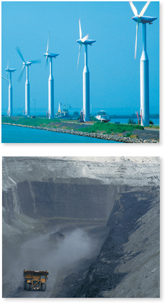Renewable and Nonrenewable Resources Ecosystem goods and services are classified as either renewable or nonrenewable, as shown in Figure 6–4. A renewable resource can be produced or replaced by a healthy ecosystem. A single southern white pine is an example of a renewable resource because a new tree can grow in place of an old tree that dies or is cut down. But some resources are nonrenewable resources because natural processes cannot replenish them within a reasonable amount of time. Fossil fuels like coal, oil, and natural gas are nonrenewable resources formed from buried organic materials over millions of years. When existing deposits are depleted, they are essentially gone forever.
Sustainable Resource Use Ecological science can teach us how to use natural resources to meet our needs without causing long-term environmental harm. Using resources in such an environmentally conscious way is called sustainable development.  Sustainable development provides for human needs while preserving the ecosystems that produce natural resources.
Sustainable development provides for human needs while preserving the ecosystems that produce natural resources.
What should sustainable development look like? It should cause no long-term harm to the soil, water, and climate on which it depends. It should consume as little energy and material as possible. Sustainable development must be flexible enough to survive environmental stresses like droughts, floods, and heat waves or cold snaps. Finally, sustainable development must take into account human economic systems as well as ecosystem goods and services. It must do more than just enable people to survive. It must help them improve their situation.

FIGURE 6–4 Natural Resources Natural resources are classified as renewable or nonrenewable. Wind and coal are both natural resources that can provide energy. But wind is renewable, while coal—like other fossil fuels—is not.
6.1 Assessment

-
Review List the three primary types of human activities that have affected regional and global environments. For each, give one benefit and one environmental cost.
Relate Cause and Effect How might more productive agricultural practices affect a developing nation's population? Its environmental health?
-
Review What is sustainable development? How can it help minimize the negative impacts of human activities?
Explain Explain why energy from the sun is a renewable resource but energy from oil is a nonrenewable resource.
Apply Concepts In addition to filtering water, wetlands provide flood control by absorbing excess water. Explain how society would provide these services (for a cost) if the ecosystem could not.
WRITE ABOUT SCIENCE
What signs of growth do you see in your community? Write a paragraph telling how this growth might affect local ecosystems.

Table of Contents
- Formulas and Equations
- Applying Formulas and Equations
- Mean, Median, and Mode
- Estimation
- Using Measurements in Calculations
- Effects of Measurement Errors
- Accuracy
- Precision
- Comparing Accuracy and Precision
- Significant Figures
- Calculating With Significant Figures
- Scientific Notation
- Calculating With Scientific Notation
- Dimensional Analysis
- Applying Dimensional Analysis




